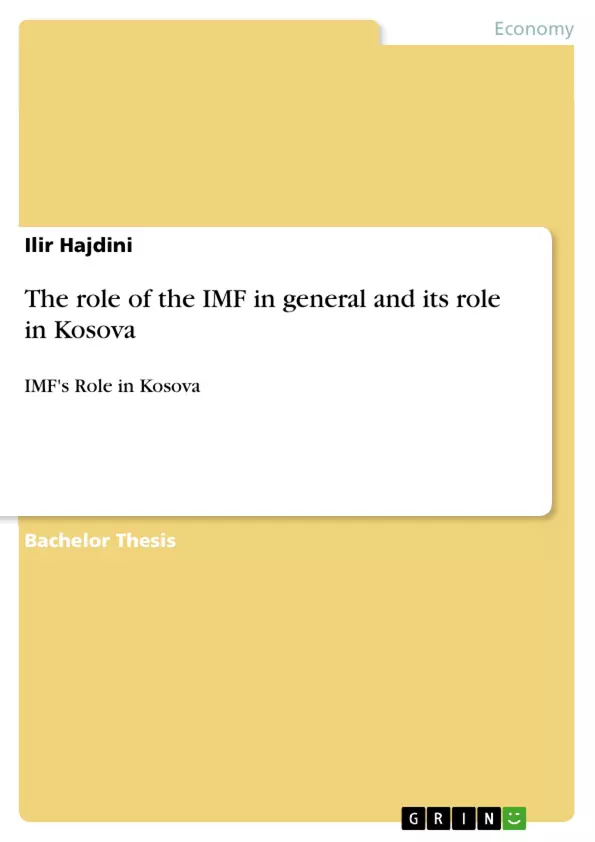This thesis will briefly introduce the role of the International Monetary Fund (IMF) in helping its members and its role today. Secondly, it will highlight the role of IMF in Kosova, its first missions in Kosova and its recommendations aid and economic activities. Finally, it will show commitments of the Kosova’s Government expressed in the LOI and IMF report and recommendations for Kosova in May 2006 combined with extracted author's conclusion and recommendations.
Inhaltsverzeichnis (Table of Contents)
- 1 INTRODUCTION
- 1.1 The IMF Objectives
- 1.2 Historic Background
- 1.3 Great Depression
- 1.4 Bretton Wood System
- 1.5 Establishment of International Money (SDR)
- 2 THE ROLE OF THE IMF IN HELPING ITS MEMBERS
- 2.1 Exchange Rate Stability through Fixed Exchange Rates
- 2.2 Breakdown of the Fixed Exchange Rate System
- 2.3 Macroeconomic and Financial Policies
- 2.4 Resolution of Crisis
- 3 THE IMF's ROLE TODAY
- 3.1 IMF and Assistance to Developing Countries
- 3.2 Technical Assistance
- 3.3 Poverty Reduction and Growth Facility
- 3.4 Heavily Indebted Poor Countries Initiative
- 3.5 Multilateral Debt Relief Initiative
- 3.6 Financial Assistance
- 4 THE ROLE OF IMF IN KOSOVA
- 4.1 Short Description of Kosova's Development Since 1999
- 4.2 The Overview of IMF Estimation of Kosova's Economy
- 5 FIRST IMF's MISSIONS IN KOSOVA AND ITS FIRST RECOMMENDATIONS
- 5.1 Kosova's Economic landscape
- 5.2 The IMF has been Active Under UN Administration
- 5.3 The Dearth of Economic Statistics
- 5.4 Official Transfers
- 6 AID AND ECONOMIC ACTIVITY IN KOSOVA
- 6.1 The Key to Medium-Term Fiscal Sustainability
- 6.2 Recommendations in Private Sector
- 6.3 Financial Sector Development
- 6.4 Privatization of Socially Owned Enterprises
- 7 COMMITMENTS OF THE KOSOVA'S GOVERNMENT EXPRESSED IN THE LOI
- 7.1 Economic Policy Strategy in LOI
- 7.2 Fiscal policy
- 7.3 Macroeconomic Objectives
- 7.4 Medium-term Policy Framework
- 7.5 Socially and Publicly Owned Enterprises
- 7.6 Financial Sector
- 7.7 Labour Market
- 7.8 Technical Assistance and Statistics
- 8 IMF REPORT AND RECOMMENDATIONS FOR KOSOVA IN MAY 2006
- 8.1 Economic Adjustment
- 8.2 Policy Makers
- 8.3 Concerns as to Whether Policies are up to the Task
- 8.4 A Deeper Public Debate on Economic Policy
- 9 CURRENT SITUATION
- 9.1 Fields In which Kosova has Made Progress
- 9.2 Fields in which Kosova Needs Improvements
Zielsetzung und Themenschwerpunkte (Objectives and Key Themes)
This thesis aims to explore the role of the International Monetary Fund (IMF) in general and its specific role in Kosovo's economic development. It examines the IMF's objectives, historical background, and its evolving role in assisting member countries, including its involvement in poverty reduction, growth promotion, and crisis resolution. The thesis then focuses on the IMF's activities in Kosovo, analyzing its recommendations and contributions to the country's economic landscape, particularly in the context of post-conflict reconstruction and development.- The IMF's role and objectives in supporting global economic stability and development
- The IMF's historical evolution and its adaptation to changing economic realities
- The IMF's approach to assisting developing countries, including its focus on poverty reduction, growth promotion, and crisis management
- The IMF's specific involvement in Kosovo's post-conflict economic reconstruction and development
- The impact of IMF policies and recommendations on Kosovo's economic performance
Zusammenfassung der Kapitel (Chapter Summaries)
The first chapter of the thesis provides an introduction to the IMF, outlining its objectives, historical background, and evolution. It discusses the Bretton Woods system, the establishment of the Special Drawing Right (SDR), and the IMF's role in promoting exchange rate stability. Chapter two explores the IMF's role in assisting its member countries. It examines how the IMF helps to maintain exchange rate stability, implement macroeconomic policies, and resolve economic crises. The chapter also discusses the IMF's role in supporting developing countries through poverty reduction programs and technical assistance. The third chapter focuses on the IMF's current role in the global economy. It highlights the IMF's efforts to promote financial stability, address global imbalances, and assist countries in overcoming economic challenges. Chapter four examines the IMF's role in Kosovo. It provides a brief overview of Kosovo's economic development since 1999 and discusses the IMF's assessment of the country's economy. Chapter five delves into the IMF's first missions in Kosovo and its initial recommendations. It describes the country's economic landscape, the IMF's involvement during UN administration, and the challenges posed by a lack of economic data. Chapter six analyzes the role of aid and economic activity in Kosovo. It examines the key factors for medium-term fiscal sustainability, the IMF's recommendations for the private sector, and its contributions to financial sector development. Chapter seven discusses the commitments of the Kosovar government as expressed in the Letter of Intent (LOI). It outlines the government's economic policy strategy, fiscal policy, macroeconomic objectives, and plans for the medium-term. Chapter eight examines the IMF's report and recommendations for Kosovo in May 2006. It highlights the IMF's concerns about economic adjustment, policy implementation, and the need for deeper public debate on economic policy.Schlüsselwörter (Keywords)
The thesis delves into the critical role of the International Monetary Fund (IMF) in promoting global economic stability and development, with a specific focus on its involvement in Kosovo's post-conflict reconstruction and economic growth. Key terms and concepts explored in the thesis include exchange rate stability, macroeconomic policies, poverty reduction, technical assistance, financial assistance, economic adjustment, and fiscal sustainability. The thesis analyzes the IMF's recommendations and contributions to Kosovo's economic landscape, taking into account the country's unique challenges and opportunities.
Excerpt out of 44 pages
- scroll top
- Quote paper
- Master of Science Ilir Hajdini (Author), 2007, The role of the IMF in general and its role in Kosova , Munich, GRIN Verlag, https://www.grin.com/document/147249
Look inside the ebook



